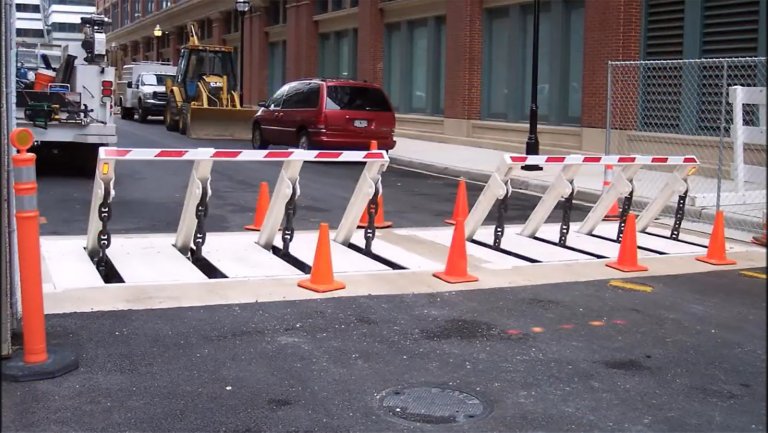Wedge Barriers Can Be Fun For Anyone
The Main Principles Of Wedge Barriers


18 might be done extra quickly, conveniently, and price efficiently. FIG. In specific personifications, the anchor 30 may be a steel structure including plates, beam of lights(e. g., I-beams ), and/or various other frameworks that are safeguarded within the structure 14, which may be concrete. At the surface area 12, an upper side 28 of the support 30 might go to the very least partially subjected
, consequently enabling the attachment of the obstacle 10 to the anchor 30. g., threaded openings)in one or more beam of lights or plates of the anchor 30 might be revealed to the surface area 12. In this manner, bolts 32 or various other mechanical bolts may be made use of to safeguard the barrier 10 to the support 30. As the obstacle 10 is installed to the surface area 12 of the foundation 14, collection of particles and other product below the barrier may be reduced, and elements of the bather 10 may not be revealed to below grade atmospheres. As suggested by recommendation character 52, the training system 50 consists of components got rid of below the wedge plate 16. The elements 52 below the wedge plate 16 may include an electromechanical actuator, a camera, one or more web cam surface areas, and so forth. Furthermore, the training system 50 consists of a spring assembly 54
The springtime pole official source 58 is combined to a camera(e. g., cam 80 shown in FIG. 4) of the lifting system 50. The springtimes 60 disposed regarding the springtime rod 58 are held in compression by springtime sustains 62, including a fixed springtime assistance 64. That is, the set spring assistance 64 is dealt with about the foundation 14 et cetera of the bather 10.
The Best Guide To Wedge Barriers
g., spring assistance 65 )may be repaired to the end of the spring pole 58 to enable compression of the springtimes 60. As the springtimes 60 are compressed in between the spring sustains 62, the spring assembly 54 generates a pressure acting upon the webcam paired to the spring rod 58 in a direction 66. The remaining pressure used to
the cam web cam deploy the wedge plate 16 may might provided supplied an electromechanical actuator 84 or other various other. As such, the springtime setting up 54 and the actuator 84(e. g., electromechanical actuator)may operate with each other to convert the cam and lift the wedge plate 16.
As discussed over, the springtime assembly 54 puts in a continuous force on the cam, while the electromechanical actuator may be managed to put in a variable pressure on the web cam, thus making it possible for the lifting and reducing( i. e., releasing and pulling back )of the wedge plate 16. In specific personifications, the constant force applied by the springtime setting up 54 might be adjustable. g., electromechanical actuator) is impaired. As will certainly be appreciated, the spring assembly 54 might be covered and protected from debris or other aspects by a cover plate(e. g., cover plate 68 received FIG. 4) that might be significantly flush with the raised surface area 38 of the structure 14. As mentioned above, in the released position, the wedge plate 16 serves to block gain access to or travel beyond the barrier 10. For instance, the obstacle 10(e. g., the wedge plate 16 )might obstruct pedestrians or vehicles from accessing a home or path. As talked about above, the barrier 10 is connected to the anchor 30 protected within the foundation 14,

front braces 71. Because of this, the affiliation settings up 72 may pivot and turn to make it possible for the collapse and extension of the linkage assemblies 72 throughout retraction and release of the bather 10. The linkage assemblies 72 reason movement of the wedge click for source plate 16 to be restricted. If a vehicle is taking a trip in the direction of the deployed wedge plate 16(e. For example, in one situation, the safety legs 86 might be expanded duringmaintenance of the barrier 10. When the security legs 86 are deployed, the safety legs 86 sustain the weight of the wedge plate 16 against the surface 12. As an outcome, the training device 50 may be deactivated, serviced, gotten rid of, replaced, and so forth. FIG. 5 is partial perspective sight of a personification of the surface-mounted wedge-style barrier 10, highlighting the camera 80 and the webcam surface areas 82 of the lifting mechanism 50. Particularly, two camera surfaces 82, which are described as reduced webcam surfaces 83, are positioned listed below the camera 80. The reduced camera surfaces 83 may be dealt with to the surface 12 (e. For instance, the lower webcam surface areas 83 and the placing plate 85 might form a solitary piece that is protected to the anchor 30 by screws or other mechanical bolts. Additionally, 2 webcam surface areas 82, which are referred to as top cam surface areas 87, are placed above the cam 80 and combined to (e. In other personifications, intervening layers or plates might be placed between the surface 12 and the reduced camera surfaces 83 and/or the wedge plate 16 and the upper cam surface areas 87 As pointed out above, the cam
80 converts along the camera surfaces 82 when the wedge plate 16 is lifted from the withdrawed setting to the deployed placement. Additionally, as stated over, the spring setting up 54 (see FIG. 3 )may provide a force acting upon the camera 80 in the direction 102 using spring rod 58, which might minimize the force the electromechanical actuator 84 is called for to apply to the camera 80 in order to activate and lift the wedge plate 16. 1 )to the released setting(see FIG. 4). As revealed, the cam 80 consists of track wheels 104(e. g., rollers), which contact and equate along the camera surface areas 82 during procedure.